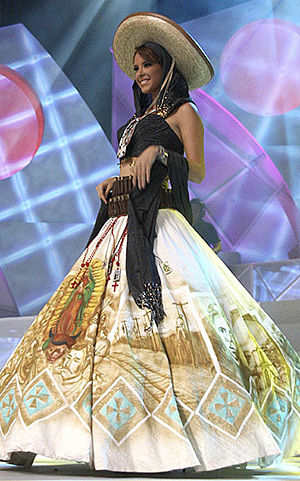 |
 |
 |
 Editorials | Issues | April 2007 Editorials | Issues | April 2007  
We Only Wanted You to Give Us a Twirl, Not a Bloody Revolution
 Thomas Cátan - timesonline.co.uk Thomas Cátan - timesonline.co.uk


| | Rosa María Ojeda’s billowing, floor-length dress recounted scenes from the 1926-29 Cristero uprising, in which Roman Catholic rebels fought against the fiercely secular Mexican Government and thousands died. |
After scandalising Mexican society, Miss Mexico is to have her dress redesigned — but not because it is too racy or revealing. For some, the outfit that Mexican judges chose for their contestant to wear at the Miss Universe contest next month seemed perfectly apt: a reference to the colourful, if blood-soaked, history of the country that has the privilege of hosting the competition.

Others were outraged. The elaborate design on its swirling skirt depicted scenes from a 1920s uprising that was violently suppressed. Critics saw it as a completely unsuitable subject for a contestant in a glamour contest. Rosa María Ojeda’s billowing, floor-length dress recounted scenes from the 1926-29 Cristero uprising, in which Roman Catholic rebels fought against the fiercely secular Mexican Government and thousands died.

Among the images on the bullet-studded dress: a man facing a firing squad and Catholic rebels shown hanging from lampposts.

The accessories included rosaries hanging from a bullet-studded belt, a crucifix necklace, a scapulary — the neck part of a nun’s or monk’s habit — and a wide-brimmed sombrero.

Designers who helped to select the dress from 30 entries argued that it represented the nation’s culture and history. “We wanted a dress that made you think of Mexico,” said Héctor Terrones, who served on the selection committee.

The gown’s designer, María del Rayo Macías, told La Jornada newspaper: “We are descendants of Cristeros. Whether we like it or not, it’s a part of who we are.”

But the three-year uprising remains a difficult part of Mexican history, and critics say a beauty pageant is hardly the right venue to air it.

“It would be like Miss USA wearing a dress showing images of the Ku Klux Klan in the Deep South, with their hoods, their burning crosses and beer cans,” said Jorge Camil, a columnist from La Jornada. Many Mexicans also felt that the dress glorified violence at a time when the country is being racked by drug-related gun crime and a rising tide of criminal offences.

After the uproar, organisers said that they would change the dress in time for the Miss Universe pageant next month in Mexico City.

The Cristero uprising

- The roadside hangings depicted on the dress represent government reprisals during the late 1920s battle between the Church and the Mexican state, which became known as the Cristero rebellion

- The conflict was precipitated by a series of anti-clerical articles in the Constitution, including banning monastic orders and limiting property rights

- In 1927, ranchers in Jalisco state rose up against the Government, armed with antique weapons. They quickly grew in size, defeating elite army units

- The rebellion continued — even after the massacre of 51 civilians by the Catholic side turned public opinion against their cause — until a settlement was negotiated in 1929

- Pope John Paul II canonised 27 Catholic martyrs from the conflict, including one who had pardoned his executioners | 
 | |
 |



